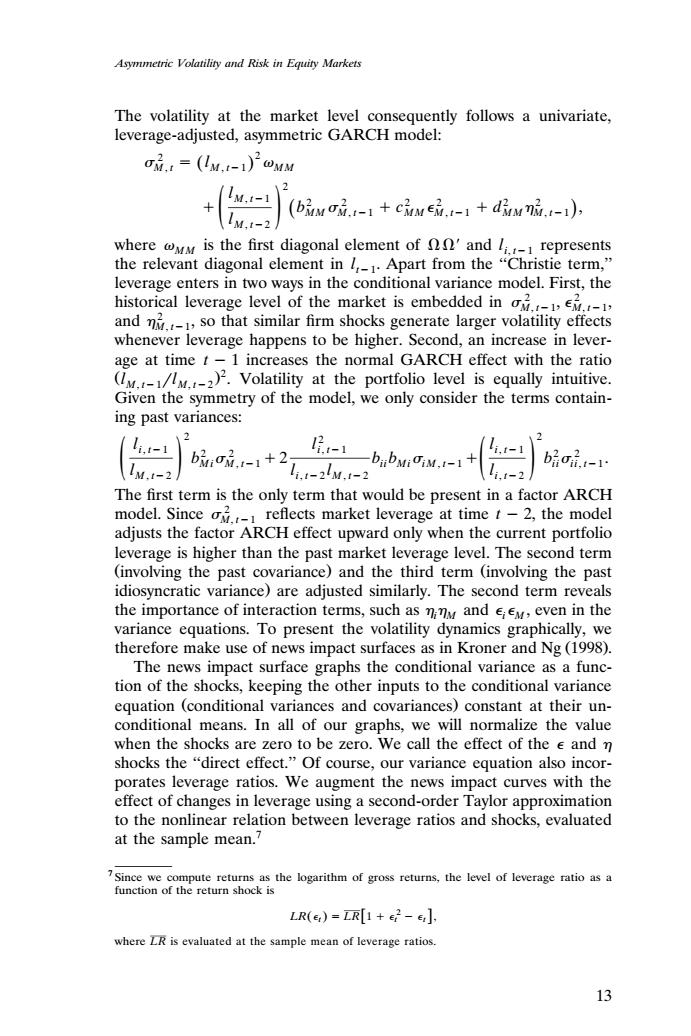正在加载图片...

Asymmetric Volatility and Risk in Equity Markets The volatility at the market level consequently follows a univariate, leverage-adjusted,asymmetric GARCH model: 07,=(LM,-1)0wM lM.1- -2 (b品w质-1+cue-1+dwn-), where is the first diagonal element of n'and i.-represents the relevant diagonal element in l,_1.Apart from the "Christie term," leverage enters in two ways in the conditional variance model.First,the historical leverage level of the market is embedded in and n,so that similar firm shocks generate larger volatility effects whenever leverage happens to be higher.Second,an increase in lever- age at time t-1 increases the normal GARCH effect with the ratio (/2)2.Volatility at the portfolio level is equally intuitive. Given the symmetry of the model,we only consider the terms contain- ing past variances: i+ 2 bci-1 it-2 The first term is the only term that would be present in a factor ARCH model.Since o.-reflects market leverage at time t-2,the model adjusts the factor ARCH effect upward only when the current portfolio leverage is higher than the past market leverage level.The second term (involving the past covariance)and the third term (involving the past idiosyncratic variance)are adjusted similarly.The second term reveals the importance of interaction terms,such as n and eeM,even in the variance equations.To present the volatility dynamics graphically,we therefore make use of news impact surfaces as in Kroner and Ng(1998). The news impact surface graphs the conditional variance as a func- tion of the shocks,keeping the other inputs to the conditional variance equation (conditional variances and covariances)constant at their un- conditional means.In all of our graphs,we will normalize the value when the shocks are zero to be zero.We call the effect of the e and n shocks the "direct effect."Of course,our variance equation also incor- porates leverage ratios.We augment the news impact curves with the effect of changes in leverage using a second-order Taylor approximation to the nonlinear relation between leverage ratios and shocks,evaluated at the sample mean.? Since we compute returns as the logarithm of gross returns,the level of leverage ratio as a function of the return shock is LR()=IR[1+e2-6]. where LR is evaluated at the sample mean of leverage ratios. 13Asymmetric Volatility and Risk in Equity Markets The volatility at the market level consequently follows a univariate, leverage-adjusted, asymmetric GARCH model: 2 2 M , t M Ž . l , t1
M M 2 lM , t1 2 2 22 22 Ž . bMM M c d , , t1 MM M , t1 MM M , t1 ž / lM , t2 where
MM i is the first diagonal element of and l represents , t1 the relevant diagonal element in l . Apart from the ‘‘Christie term,’’ t1 leverage enters in two ways in the conditional variance model. First, the historical leverage level of the market is embedded in 2 , 2 M , , t1 M, t1 and 2 M , so that similar firm shocks generate larger volatility effects , t1 whenever leverage happens to be higher. Second, an increase in leverage at time t 1 increases the normal GARCH effect with the ratio Ž .2 lM l . Volatility at the portfolio level is equally intuitive. , t1 M, t2 Given the symmetry of the model, we only consider the terms containing past variances: 2 2 2 lll i, t1 i, t1 i, t1 2 2 22 bMi M 2 b b b . , t1 ii Mi iM , t1 ii ii, t1 ž / ž/ l ll l M , t2 i, t2 M , t2 i, t2 The first term is the only term that would be present in a factor ARCH model. Since 2 M reflects market leverage at time t 2, the model , t1 adjusts the factor ARCH effect upward only when the current portfolio leverage is higher than the past market leverage level. The second term Ž .Ž involving the past covariance and the third term involving the past idiosyncratic variance are adjusted similarly. The second term reveals . the importance of interaction terms, such as and , even in the iM iM variance equations. To present the volatility dynamics graphically, we therefore make use of news impact surfaces as in Kroner and Ng 1998 . Ž . The news impact surface graphs the conditional variance as a function of the shocks, keeping the other inputs to the conditional variance equation conditional variances and covariances constant at their un- Ž . conditional means. In all of our graphs, we will normalize the value when the shocks are zero to be zero. We call the effect of the and shocks the ‘‘direct effect.’’ Of course, our variance equation also incorporates leverage ratios. We augment the news impact curves with the effect of changes in leverage using a second-order Taylor approximation to the nonlinear relation between leverage ratios and shocks, evaluated at the sample mean.7 7 Since we compute returns as the logarithm of gross returns, the level of leverage ratio as a function of the return shock is 2 LRŽ . LR 1 , t tt where LR is evaluated at the sample mean of leverage ratios. 13���������